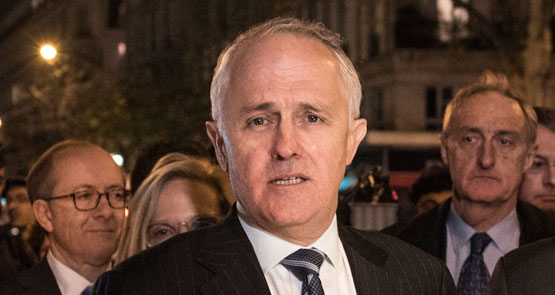
One of the things that makes life difficult for Australian mainstream politicians trying to do something effective about Australia’s carbon emissions — apart from being white-anted by colleagues — is that voters seem to wax and wane on the urgency of climate action. John Howard found that his years of denialism on climate change were suddenly a burden in 2007, leaving him scrambling to catch up with Labor, which had read a mood shift in favour of action in the electorate. Tony Abbott, in turn, exploited both a sense of disenchantment after the failed Copenhagen conference and, of course, perceptions of Julia Gillard’s broken promise on the issue.
Now, the pendulum is again swinging in favour of climate action, and the Coalition — still riven by denialists and crony capitalists keener to look after favoured sectors rather than the national interest — in the one that again faces a challenge.
That’s why Labor’s embrace of much higher emission abatement targets last week was less crazy brave that it seemed. Not merely is there an electoral mood for more action on climate change, but voters will be far more sceptical of any Coalition scare campaign after Tony Abbott’s over-the-top attacks on Julia Gillard’s carbon pricing scheme, in which precisely none of the claims Abbott, Greg Hunt and co made were ever borne out.
Voters might also notice that the removal of the carbon price preceded a collapse in investment and tepid economic growth. All purely coincidental, of course.
You can tell there’s been a shift in sentiment: business is now making pro-climate action noises, whereas the debate used to be dominated by rentseekers and special interests like the mining industry and power companies complaining about sovereign risk and predicting the end of the world. Part of this is that mining companies are suddenly more worried about survival than grandstanding in political debate, and another part must surely be a reaction against the maniacal hatred of renewables that marked the Abbott government — voters like renewable energy, and they like governments supporting it, no matter how much some conservatives hate windfarms.
But what confirms an electoral shift back to more aggressive action is that the government is now flagging that it may go above its current, embarrassing target of 26% reduction on 2005 levels by 2030, telling The Australian targets might be reviewed upward if there was a “comprehensive global agreement”.
It’s been only a couple of days since Labor’s 45% target was being attacked as economically destructive in terms that recalled the python squeezes, cobra strikes and Whyalla wipeouts of the Abbott years. In fact, buried inside the Oz today was exactly that sort of stuff from Coalition backbencher Angus Taylor (though sadly lacking the famous $100 leg of lamb), while the front page was signalling that Turnbull understood that for all his talk, he was going to Paris with a decidedly unimpressive package, both internationally and domestically.
If you’re trying to work out why Labor’s higher targets are economically destructive while the government says it’s prepared to lift its target, it’s all about trading permits, which would allow Australia to set a higher target and trade its way to reach it. The phrase, not to mention the concept, of trading emissions was banned under Tony Abbott, so any scheme involving trading will have to be carefully presented to avoid any suggestion of being market-based — lest the Nationals and the hard right, outraged by the employment of the core mechanism of capitalism, rebel.
But given Direct Inaction won’t even achieve a fraction of the Coalition’s target, the government needs something in order to credibly commit to it. So far the only thing on offer from Turnbull is this sort of blather about private sector technology, in which the Turnbull Era deities of Agility and Innovation will descend to the Earth and hackathon the problem away.
Labor, to its credit, is committed to a return to an emissions trading scheme, and made that commitment well over a year ago, but we know virtually nothing about how the scheme will work. It might be a bit much to expect an opposition to produce a full-blown emissions trading scheme policy, but as Lenore Taylor has been pointing out for a long time, it means neither side has a convincing, detailed policy to back up its emissions abatement target, ambitious or otherwise.
It makes the debate over such targets rather theatrical. And there’s been more than enough of that over the last decade on climate change.








Another sign the coal companies are worried: They are advertising on the skeptic channels (in Sydney 2GB and, on select ‘skeptic’ radio commentators; 2UE) a “coal is good” advertising.
The coal companies are on a short road to nowhere and any political leader proclaiming “Coal is good” is on the political version of that short road; Messiahs included.
A further example that the LNP hasn’t a clue is Pyne and ScoMo parroting the same old Abbotesque diatribes when being critical of Labours announcements of %.
Bring on the election!
I’d hazard a guess that working up an ETS for Labor will simply involve pulling the old one out of the bottom drawer and dusting it off. With some minor modifications. It is what it is, how much needs to change anyway?
Isn’t it fortunate then that Malcolm now has as his Departmental Secretary Martin Parkinson, the man who led development of the carbon pricing scheme introduced under Labor?
‘… Labor’s 45% target was being attacked as economically destructive…’
But the consequences of climate change won’t be economically destructive, is that what the government is implying?
When Turnbull damned Shorten’s 45% target as ‘heroic’ it should’ve been taken as a compliment. MPs and heroic don’t usually belong in the same sentence.
Anyone wanting to see heroic positions from Turnbull will be waiting a long time. He does have a problem with one of the world’s greatest ‘red herrings’ – Climate Change.